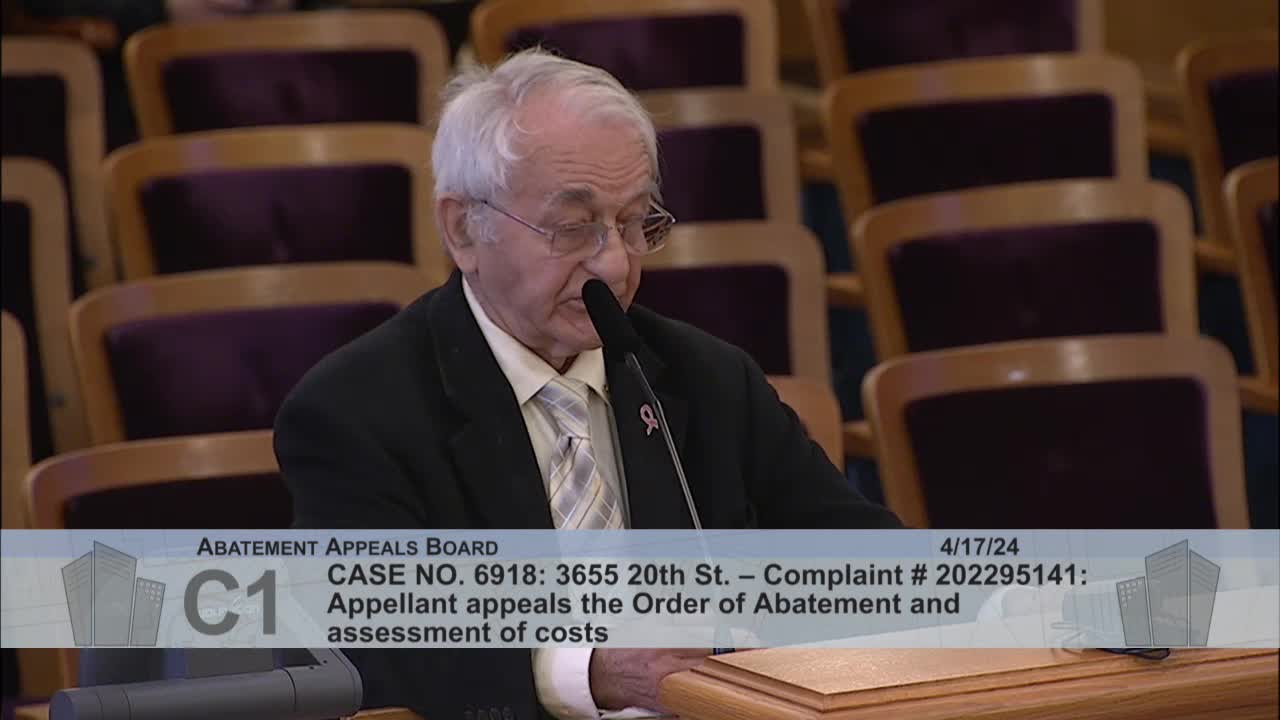City board reviews abatement order amid safety concerns over retaining walls
April 17, 2024 | San Francisco City, San Francisco County, California

This article was created by AI summarizing key points discussed. AI makes mistakes, so for full details and context, please refer to the video of the full meeting. Please report any errors so we can fix them. Report an error »

In the heart of San Francisco's city hall, a tense discussion unfolded as city officials addressed a contentious safety issue regarding a property in disrepair. The meeting, held on July 4, 2025, centered around an order of abatement issued to a property owner, raising questions about life safety hazards and compliance with city regulations.
The dialogue began with a board member seeking clarity on whether the property posed an imminent safety risk. While some asserted that the situation was not a life safety hazard, the absence of a formal engineering report left uncertainty hanging in the air. The owner’s representative acknowledged that only verbal assurances had been provided, which did little to quell the concerns of the board.
Commissioner Summer emphasized the procedural aspect of the case, noting that the owner had been given a 30-day window to address the issues following a director's hearing. However, the owner failed to comply, prompting the order of abatement. The discussion turned to the physical state of the property, where a large piece of concrete had been deemed hazardous. Although some of it had been removed, the board noted that temporary plywood barriers were still in place, indicating that the situation remained unresolved.
As the conversation progressed, it became clear that communication breakdowns had contributed to the current predicament. The owner claimed ignorance of the abatement process, while city officials maintained that proper notifications had been issued. This discrepancy highlighted the complexities of property management and regulatory compliance in urban settings.
The meeting also touched on the role of engineering assessments in determining safety risks. The owner’s representative mentioned ongoing efforts to engage a new engineer to develop a more robust design for the retaining walls, which had been criticized for their structural integrity. The board's inquiries revealed a lack of clarity regarding the timeline of inspections and the documentation of safety concerns.
As the meeting drew to a close, the board faced the challenge of balancing regulatory enforcement with the realities of property ownership. The discussions underscored the importance of clear communication and thorough documentation in addressing safety issues, leaving attendees pondering the implications for both the property owner and the community at large. The outcome of this case could set a precedent for how similar situations are handled in the future, emphasizing the need for vigilance in maintaining safety standards in San Francisco's diverse neighborhoods.
The dialogue began with a board member seeking clarity on whether the property posed an imminent safety risk. While some asserted that the situation was not a life safety hazard, the absence of a formal engineering report left uncertainty hanging in the air. The owner’s representative acknowledged that only verbal assurances had been provided, which did little to quell the concerns of the board.
Commissioner Summer emphasized the procedural aspect of the case, noting that the owner had been given a 30-day window to address the issues following a director's hearing. However, the owner failed to comply, prompting the order of abatement. The discussion turned to the physical state of the property, where a large piece of concrete had been deemed hazardous. Although some of it had been removed, the board noted that temporary plywood barriers were still in place, indicating that the situation remained unresolved.
As the conversation progressed, it became clear that communication breakdowns had contributed to the current predicament. The owner claimed ignorance of the abatement process, while city officials maintained that proper notifications had been issued. This discrepancy highlighted the complexities of property management and regulatory compliance in urban settings.
The meeting also touched on the role of engineering assessments in determining safety risks. The owner’s representative mentioned ongoing efforts to engage a new engineer to develop a more robust design for the retaining walls, which had been criticized for their structural integrity. The board's inquiries revealed a lack of clarity regarding the timeline of inspections and the documentation of safety concerns.
As the meeting drew to a close, the board faced the challenge of balancing regulatory enforcement with the realities of property ownership. The discussions underscored the importance of clear communication and thorough documentation in addressing safety issues, leaving attendees pondering the implications for both the property owner and the community at large. The outcome of this case could set a precedent for how similar situations are handled in the future, emphasizing the need for vigilance in maintaining safety standards in San Francisco's diverse neighborhoods.
View full meeting
This article is based on a recent meeting—watch the full video and explore the complete transcript for deeper insights into the discussion.
View full meeting
